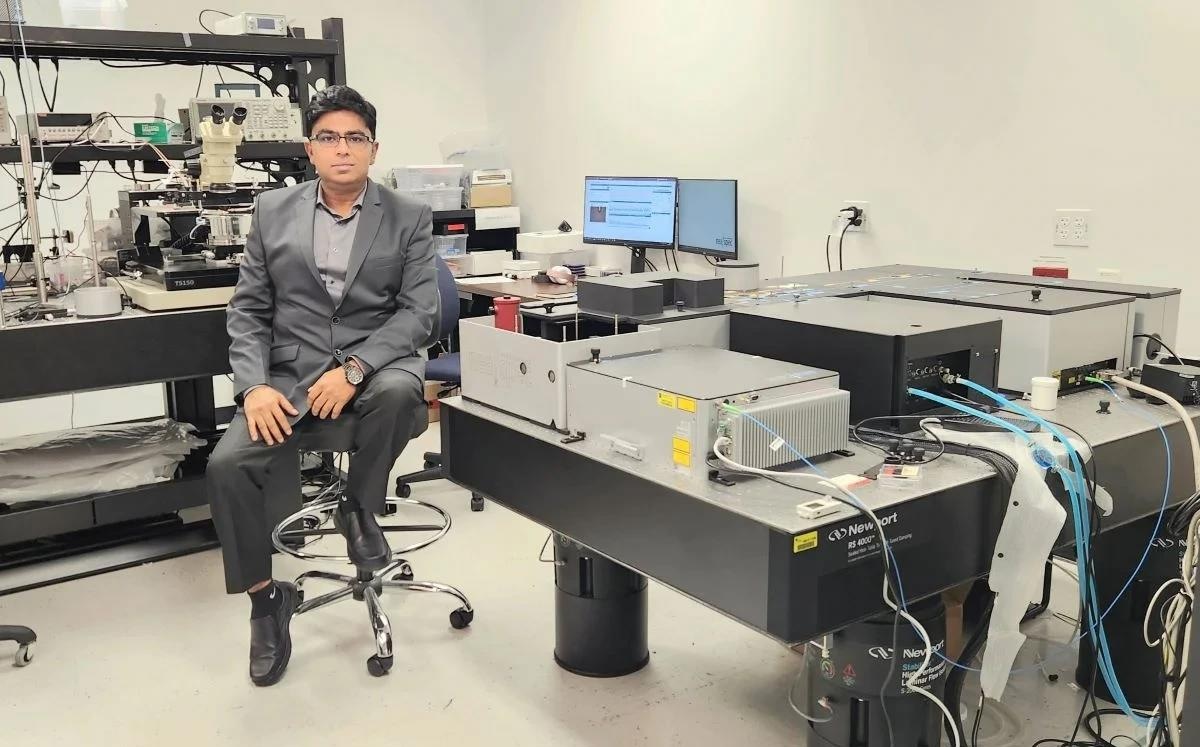UCF researcher Debashis Chanda, a Professor at the NanoScience Technology Center, has advanced a new technique to identify photons - elementary particles that span from visible light to radio frequencies and are instrumental in carrying cellular communication.

Image Credit: University of Central Florida
This progress may result in more accurate and effective technology across a range of domains, including communication and medical imaging, science, and possibly even security measures.
Traditionally, photon detection depends on voltage or current amplitude modulation or change. However, Chanda has made progress toward ultra-sensitive photon detection by creating a method of detecting photons by varying the frequency of an oscillating circuit.
Chanda’s technique makes use of a unique phase-change material (PCM) that, in response to light, alters its shape, creating a stable electrical circuit oscillation or constant rhythm. A photon of light striking the substance causes the oscillation frequency to alter, or how quickly the rhythm beats. Just as a person’s voice alters the sound on the radio, the intensity of the light affects the change of the rhythm.
The new development is published in Advanced Functional Materials.
In the 8-12 µm wavelength region, long wave infrared (LWIR) detection is crucial for astronomy, climate science, materials analysis, and security. However, the low energy of photons has long been a difficulty for LWIR detection at ambient temperature.
The two main types of LWIR detectors that are now on the market are cooled and uncooled detectors, each of which has certain drawbacks.
Although cooled detectors have high detection rates, their practical utility is limited, and the need for cryogenic cooling increases the cost. On the other hand, because room temperature operation introduces a higher level of thermal noise, uncooled detectors can function at room temperature but have poor detection and sluggish response times. The development of an inexpensive, rapid, extremely sensitive infrared detector/camera still faces technical and scientific obstacles.
This is why LWIR cameras are not widely used except in the Department of Defense and space-specific applications.
Chanda says, “Unlike all present photon detection schemes where light power changes the amplitude of voltage or current (amplitude modulation - AM), in the proposed scheme hits, or incidents of photons, modulate the frequency of an oscillating circuit and are detected as a frequency shift, offering inherent robustness to noises, which are AM in nature.”
“Our FM-based approach yields an outstanding room temperature noise equivalent power, response time, and detectivity. This general FM-based photon detection concept can be implemented in any spectral range based on other phase-change materials,” Chanda adds.
Our results introduce this novel FM-based detector as a unique platform for creating low-cost, high-efficiency uncooled infrared detectors and imaging systems for various applications such as remote sensing, thermal imaging, and medical diagnostics. We strongly believe that the performance can be further enhanced with proper industry-scale packaging.
Debashis Chanda, Department of Physics, University of Central Florida
As noise reduces detection sensitivity, the Chanda group’s proposal offers a paradigm change to highly sensitive, uncooled LWIR detection. This finding suggests a novel, low-cost, very sensitive uncooled LWIR detection system that may be readily integrated with electronic readout circuitry without requiring intricate hybridization.
The fundamental research is sponsored under a US National Science Foundation grant #ECCS-2015722. The camera technology is under development with funding from Chanda’s Samsung Global Research Outreach Award 2022.
Journal Reference
Guo, T., et al. (2023). Frequency Modulation Based Long-Wave Infrared Detection and Imaging at Room Temperature. Advanced Functional Materials. doi.org/10.1002/adfm.202309298